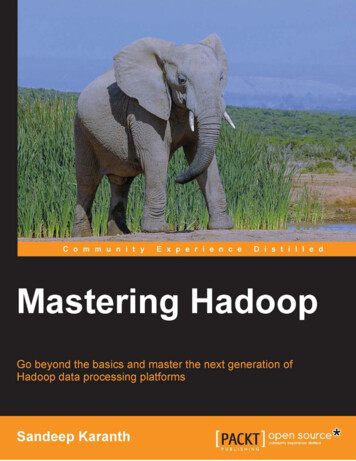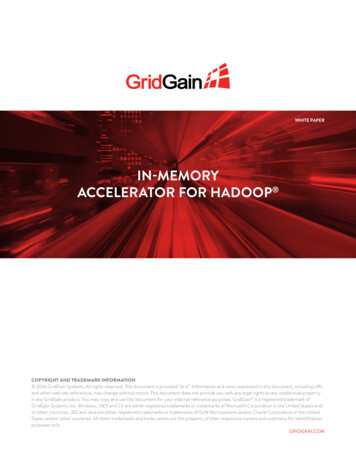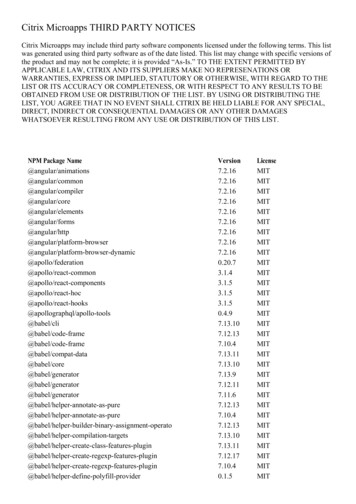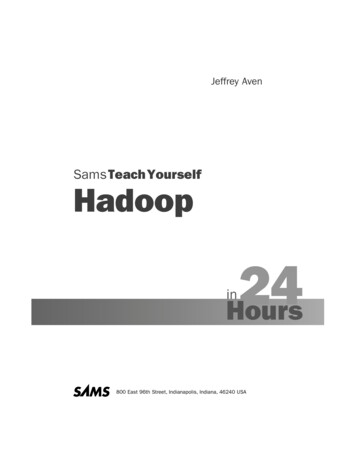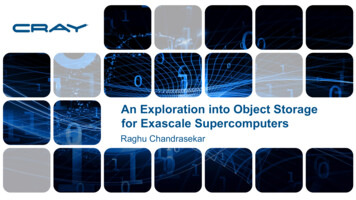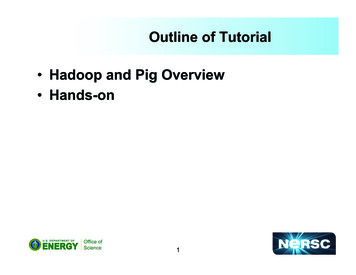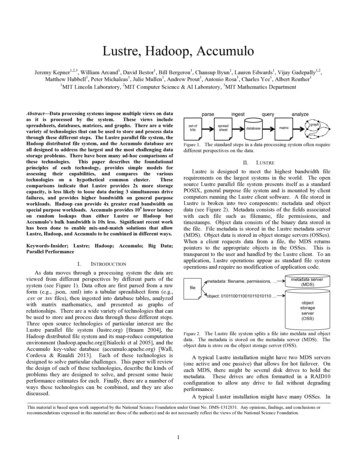
Transcription
Lustre, Hadoop, AccumuloJeremy Kepner1,2,3, William Arcand1, David Bestor1, Bill Bergeron1, Chansup Byun1, Lauren Edwards1, Vijay Gadepally1,2,Matthew Hubbell1, Peter Michaleas1, Julie Mullen1, Andrew Prout1, Antonio Rosa1, Charles Yee1, Albert Reuther11MIT Lincoln Laboratory, 2MIT Computer Science & AI Laboratory, 3MIT Mathematics DepartmentAbstract—Data processing systems impose multiple views on dataas it is processed by the system.These views includespreadsheets, databases, matrices, and graphs. There are a widevariety of technologies that can be used to store and process datathrough these different steps. The Lustre parallel file system, theHadoop distributed file system, and the Accumulo database areall designed to address the largest and the most challenging datastorage problems. There have been many ad-hoc comparisons ofthese technologies.This paper describes the foundationalprinciples of each technology, provides simple models forassessing their capabilities, and compares the varioustechnologies on a hypothetical common cluster.Thesecomparisons indicate that Lustre provides 2x more storagecapacity, is less likely to loose data during 3 simultaneous drivefailures, and provides higher bandwidth on general purposeworkloads. Hadoop can provide 4x greater read bandwidth onspecial purpose workloads. Accumulo provides 105 lower latencyon random lookups than either Lustre or Hadoop butAccumulo’s bulk bandwidth is 10x less. Significant recent workhas been done to enable mix-and-match solutions that allowLustre, Hadoop, and Accumulo to be combined in different ways.parse!set hFigure 1. The standard steps in a data processing system often requiredifferent perspectives on the data.II.LUSTRELustre is designed to meet the highest bandwidth filerequirements on the largest systems in the world. The opensource Lustre parallel file system presents itself as a standardPOSIX, general purpose file system and is mounted by clientcomputers running the Lustre client software. A file stored inLustre is broken into two components: metadata and objectdata (see Figure 2). Metadata consists of the fields associatedwith each file such as filename, file permissions, andtimestamps. Object data consists of the binary data stored inthe file. File metadata is stored in the Lustre metadata server(MDS). Object data is stored in object storage servers (OSSes).When a client requests data from a file, the MDS returnspointers to the appropriate objects in the OSSes. This istransparent to the user and handled by the Lustre client. To anapplication, Lustre operations appear as standard file systemoperations and require no modification of application code.Keywords-Insider; Lustre; Hadoop; Accumulo; Big Data;Parallel PerformanceI.ingest!INTRODUCTIONAs data moves through a processing system the data areviewed from different perspectives by different parts of thesystem (see Figure 1). Data often are first parsed from a rawform (e.g., .json, .xml) into a tabular spreadsheet form (e.g.,.csv or .tsv files), then ingested into database tables, analyzedwith matrix mathematics, and presented as graphs ofrelationships. There are a wide variety of technologies that canbe used to store and process data through these different steps.Three open source technologies of particular interest are theLustre parallel file system (lustre.org) [Braam 2004], theHadoop distributed file system and its map-reduce computationenvironment (hadoop.apache.org)[Bialecki et al 2005], and theAccumulo key-value database (accumulo.apache.org) [Wall,Cordova & Rinaldi 2013]. Each of these technologies isdesigned to solve particular challenges. This paper will reviewthe design of each of these technologies, describe the kinds ofproblems they are designed to solve, and present some basicperformance estimates for each. Finally, there are a number ofways these technologies can be combined, and they are alsodiscussed.metadata: filename, permissions, filemetadata server(MDS)object: 010110011001011010110 objectstorageserver(OSS)Figure 2. The Lustre file system splits a file into metdata and objectdata. The metadata is stored on the metadata server (MDS). Theobject data is store on the object storage server (OSS).A typical Lustre installation might have two MDS servers(one active and one passive) that allows for hot failover. Oneach MDS, there might be several disk drives to hold themetadata. These drives are often formatted in a RAID10configuration to allow any drive to fail without degradingperformance.A typical Luster installation might have many OSSes. InThis material is based upon work supported by the National Science Foundation under Grant No. DMS-1312831. Any opinions, findings, and conclusions orrecommendations expressed in this material are those of the author(s) and do not necessarily reflect the views of the National Science Foundation.1
turn, each OSS can have a large number of drives that are oftenformatted in a RAID6 configuration to allow for the failure ofany two drives in an OSS. The many drives in an OSS allowsdata to be read in parallel at high bandwidth. File objects arestriped across multiple OSSes to further increase parallelperformance.The above redundancy is designed to give Lustre highavailability and no single point of failure. Data loss can onlyoccur if three drives fail in the same OSS prior to any one ofthe failures being corrected. This probability is given by:P3 (nd P1)((nd/ns -1) P1) ((nd/ns -2) P1) (nd3/ns2) P13,whereP3 probability that 3 drives fail in the same OSSP1 probability that a single drive failsnd number of drives in the entire systemns number of object storage serversFor a typical system with ns 10, then P3 (nd P1)3 / 100.The typical storage penalty for this redundancy is 35%.Thus, a system with 6 petabytes of raw storage might provide 4petabytes of data capacity to its users.Lustre is designed to deliver high read and writeperformance for many simultaneous large files. This isachieved by the clients having a direct connection to the OSSesvia a high speed network. This connection is brokered by theMDS. The peak bandwidth of Lustre is determined by theaggregate network bandwidth to the client systems, thebisection bandwidth of the network switch, the aggregatenetwork connection to the OSSes, and the aggregate bandwidthof the all the disks. More precisely, total Lustre bandwidth isgiven byB-1 (nc Bc)-1 (Bn)-1 (ns Bs)-1 (nd Bd)-1whereB total Luster bandwidthnc number of clientsBc bandwidth of each clientBn bisection bandwidth of the network switchns number of object storage serversBs bandwidth of each object storage servernd number of drives in the systemBd bandwidth of each driveConsider a typical Lustre system wherenc 100Bc 1 GB/secBn N/A (i.e., 1:1 non-blocking switch)ns 10Bs 4 GB/snd 1000Bd 0.1 GB/sec B 22 GB/secLike most file systems Lustre is designed for sequential readaccess and not random lookups of data. To find any particulardata value in Lustre requires on average scanning through halfthe file system.For the system described above with 4petabytes of user storage, this would require 1 day.Finally, the Lustre security model is standard unixpermissions.III.HADOOPHadoop is a fault-tolerant, distributed file system anddistributed computation system. The Hadoop distributed filesystem (HDFS) is modeled after the Google File System(GFS)[Ghemawat et al 2003] and is a scalable distributed filesystem for large distributed data-intensive applications. GFSprovides fault tolerance while running on inexpensivecommodity hardware, and it delivers high aggregateperformance to a large number of clients. The Hadoopdistributed computation system uses the map-reduce parallelprogramming model for distributing computation onto the datanodes.The foundational assumptions of HDFS are that itshardware and applications have the following properties[HDFS 2015]: high rates of hardware failures, special purposeapplications, large data sets, write-once-read-many data, andread dominated applications. HDFS is designed for animportant, but highly specialized class of applications for aspecific class of hardware. In HDFS, applications primarilyemploy a co-design model whereby the HDFS file system isaccessed via specific calls associated with the Hadoop API.metadata: filename, replicas, name nodeblocks: 010110011001011010110 data nodefiledata nodedata nodeFigure 3. HDFS splits a file into metdata and replicated data blocks.The metadata is stored on the name node. The data blocks are storedon the data nodes.A file stored in HDFS is broken into two components:metadata and data blocks (see Figure 3). Metadata consists ofvarious fields such as the filename, creation date, and thenumber of replicas. Data blocks consist of the binary datastored in the file. File metadata is stored in the HDFS namenode. Block data is stored on data nodes. HDFS is designed tostore very large files that will be broken up into multiple datablocks. In addition, HDFS is designed to support faulttolerance in massive distributed data centers. Each block has aspecified number of replicas that are distributed across differentdata nodes.“The placement of replicas is critical to HDFS reliabilityand performance. Optimizing replica placement distinguishesHDFS from most other distributed file systems. This is afeature that needs lots of tuning and experience.” [HDFS R121]One common HDFS replication policy is to store threecopies of each data block in a location aware manner so thatone copy is in another rack in the data center and that a secondcopy is in another data center. With this policy, the data willbe protected from both rack unavailability and data centerunavailability.2
The storage penalty for a triple replication policy is 66%.Thus, a system with 6 petabytes of raw storage might provide 2petabytes of data capacity to its users.Data loss can only occur if three drives fail prior to any oneof the failures being corrected. This probability is given by:P3 (nd P1)((nd -1) P1) ((nd -2) P1) (nd P1)3Hadoop is Java software that is typically installed in aspecial Hadoop user account and runs various Hadoop deamonprocesses to provide services to its clients.Hadoopapplications contain special API calls to access the HDFSservices. A typical Hadoop application using the map-reduceprogramming model will distribute an application over the filesystem so that each application is exclusively reading blocksthat are local to the node that it is running on. A well-writtenHadoop application can achieve very high performance if theblocks of the files are well distributed across the data nodes.Hadoop applications use the same hardware for storage andcomputation. The bandwidth achieved out of HDFS is highlydependent upon the computation to communication ratio of theHadoop application. The total Hadoop read bandwidth foroptimally placed data blocks is given byBwrite min(nc,nd)Bd/RBread min(nc,nd)Bd/(1 r)whereB total HDFS bandwidthnc number of clientsR replicationr local compute time to read time rationd number of disksBd bandwidth of each diskConsider a typical HDFS system wherenc 1000R 3nd 1000Bd 0.1 GB/sec Bwrite 33 GB/secThe compute time to read time ratio of a Hadoop applicationhas a wide range. HDFS is designed for read dominatedapplications. For example, counting the number of words in afile involves reading all the data in the file and counting thenumber of bytes corresponding to the word separatorcharacters. In this case, the local compute time to read timeratio r 0 Bread 100 GB/sec. Likewise, an application thatsorts and parses words in a complex manner may have localcompute time to read time ratio r 1000 Bread 100MB/sec.Like most file systems, HDFS is designed for sequentialread access and not random lookups of data. To find anyparticular data value in HDFS requires scanning through halfthe file system.For the system described above with 4petabytes of user storage, this would require 3 hours assumingthere is no other compute load on the Hadoop processors.Finally, the HDFS security model is migrating towardsstandard unix permissions.IV.ACCUMULORelational or SQL (Structured Query Language) databases[Codd 1970, Stonebraker et al 1976] have been the de factointerface to databases since the 1980s and are the bedrock ofelectronic transactions around the world. More recently, keyvalue stores (NoSQL databases) [Chang et al 2008] have beendeveloped for representing large sparse tables to aid in theanalysis of data for Internet search. As a result, the majority ofthe data on the Internet is now analyzed using key-value stores[DeCandia et al 2007, Lakshman & Malik 2010, George 2011].In response to the same challenges, the relational databasecommunity has developed a new class of array store(NewSQL) databases [Stonebraker et al 2005, Kallman et al2008, Stonebraker & Weisberg 2013] to provide the features ofrelational databases while also scaling to very large data sets.AccumuloclientsBasesubGraphgraphtablet serverTabletTabletTabletTabletTablettabletHadoop data nodeAccumuloclients BasesubGraphgraphtablet serverTabletTabletTabletTabletTablettabletHadoop data nodeFigure 4. Accumulo is ideally suited for storing large graphs intables. Tables are split into tablets that are hosted on tablet serversthat reside on Hadoop data nodes. Accumulo client processes thencan access different portions of the graph in parallel.Accumulo is a unique NoSQL database that it is designedfor the highest possible performance and scalability while alsoproviding security labels for every entry in the database.Accumulo uses HDFS as its storage system. All Accumulointernal read and write processes are scheduled out of its ownthread pool that is managed independently of the Hadoop mapreduce scheduler. Accumulo’s main dependency on Hadoop isHDFS.Accumulo is designed to run on large clusters of computinghardware where each node in the cluster has its own datastorage. Accumulo uses the Hadoop Distributed File System(HDFS) to organize the storage on the nodes into a single,large, redundant file system (see Figure 4). A table inAccumulo is broken up into tablets where each tablet contains acontinuous block of rows. The row values marking theboundaries between tablets are called splits. A table can bebroken up into many tablets, and these tablets are then stored inHDFS across the cluster. Good performance is achieved whenthe data and the operations are spread evenly across the cluster.The selection of good splits is key to achieving this goal.The various Accumulo processes are managed byZookeeper (zookeeper.apache.org), which is a centralizedservice for maintaining configuration and naming information,along with providing distributed synchronization and groupservices.Accumulo’s data redundancy relies on theunderlying HDFS replication. Accumulo’s availability relieson a heartbeat mechanism by which each Accumulo tabletserver regularly reports in to Zookeeper. If a tablet server failsto report, Accumulo assumes the tablet server is unavailableand will not attempt to read from or write to the tablet server.3
Accumulo is a key-value store where each entry consists ofa seven-tuple. Most of the concepts of Accumulo can beunderstood by reducing this seven-tuple into a triple consistingof a row, column, and value. Each triple describes a point in atable. Only the non-empty entries are stored in each row, sothe table can have an almost unlimited number of rows andcolumns and be extremely sparse, which makes Accumulo wellsuited for storing graphs.their respective domains. Their common focus on performanceand scalability via well-supported open source projectsnaturally brings these two communities together. Accmulo’srelatively narrow dependence on HDFS means Accumulo issomewhat independent of its underlying storage environment,and applications don’t need to be changed if underlying storagechanges. Currently, there are two primary ways for Accumuloand Lustre to coexist: HDFS on Lustre and checkpoint/restarton Lustre.As discussed in the previous section, running HDFS andHadoop map-reduce on Lustre has been demonstrated by anumber of organizations and is an available product. TheAccumulo database has its own set of processes that runoutside of Hadoop map-reduce. Accumulo’s high availability isachieved by using heartbeat based fault-tolerance policies thatcan make Accumulo more susceptible to global systemavailability pauses then a standard Hadoop map-reduce job.Global system availability is a pressing concern in resourceconstrained environments such a cloud VM environments. Insuch environments, as resource limits are approached, thesystem experiences pauses that can trigger Accumulo’s faulttolerance mechanism to be invoked globally. Recent work bythe Accumulo community [Fuchs 2015] has made significantprogress for diagnosing when Accumulo is approachingresource limits (e.g., RAM limits) and to more gracefullyhandle its processes as resource limits are approached. Theexact same issue can also be a concern for a Lustre system. Ifthe Lustre MDS becomes heavily loaded, it may momentarilyrespond more slowly which can invoke the Accumulo faulttolerance mechanism. The recent efforts to improve Accumulobehavior on VMs are also applicable to improving Accumulorunning on Lustre.A typical large Accumulo instance is physically coupled toits underlying compute system. Starting, stopping, checkpoint,cloning, and restarting an Accumulo instance on differenthardware is difficult. Likewise keeping many production scaleAccumulo instances available for database developers can alsobe challenging. Lustre can play an obvious role in this settingby being a repository by which entire Accumulo instances canbe stored while they are not running. The MIT SuperCloud[Reuther et al 2013, Prout et al 2015] adopts this approach andit has proven to be very useful for developers and for managingproduction Accumulo instances.The performance of Accumulo (and many other databases)is most commonly measured in terms of the rate at whichentries can be inserted into a database table. A detailedmathematical model of Accumulo insert performance is beyondthe scope of this paper. The peak performance of Accumulohas been measured at over 100,000,000 entries per second[Kepner et al 2014]. The peak insert rate for a single thread istypically 100,000 entries per second. A typical single nodeserver can reach 500,000 entries per second using severalinsert threads [Sawyer 2013]. For the hypothetical Hadoopcluster described in the previous section, the peak performancewould be 100,000,000 entries per second. If a typical entrycontains 30 bytes of data, this corresponds to a peak insertbandwidth of 3 Gigabytes/sec.The Accumulo security model is a unique algebra thatallows each data entry to be labeled so that a variety of testscan be done to determine if the data should be returned to theuser.V.HADOOP ON LUSTREAs the Hadoop community has grown, it has become anincreasingly popular API for a variety of applications.Applications written to the Hadoop map-reduce API nowrepresent “legacy” applications in many organizations.Likewise, applications written to traditional file systems arealso extremely popular and thus there has been strong interestin determining how these applications can coexist on sharedcomputing hardware [Rutman 2011, Kulkarni 2013, DDN2013, System Fabric Works 2014, Seagate 2014, Seagate2015]. There are two primary approaches to running Hadoopapplications on Lustre: porting map-reduce applications toHadoop and swapping the underlying Hadoop file system forLustre.The first approach is to rewrite the Hadoop applications touse the map-reduce parallel programming model without usingthe Hadoop API [Byun et al 2012, Byun et al 2015]. Thisprocess mostly consists of removing the Hadoop API callsfrom the application and replacing them with regular filesystem calls. The application is then run using any of a numberof standard schedulers. At the prices of porting the code, thenet result of this process is usually applications that are smaller,easier to maintain, and run faster.The second approach is modify the Lustre client with aplugin that replaces, or augments, the default Hadoop filesystem with the Lustre File System, which writes to a sharedLustre mount point that is accessible by all machines in theHadoop cluster [Seagate 2015].VI.VII. SUMMARYThe Lustre parallel file system, the Hadoop distributed filesystem, and the Accumulo database are all designed to addressthe largest and the most challenging data storage problems.There have been many ad-hoc comparisons of thesetechnologies. This paper describes the foundational principlesof each technology, provides simple models for assessing theircapabilities, and compares the various technologies on ahypothetical common cluster. These comparisons are shown inTable 1 and indicate that the Lustre provides 2x more storagecapacity, is less likely to loose data during 3 simultaneous drivefailures, and provides higher bandwidth across general purposeworkloads. Hadoop can provide 4x greater read bandwidth onspecial purpose workloads. Accumulo provides 105 lowerlatency on random lookups than either Lustre or Hadoop butAccumulo’s overall bandwidth is 10x less. Significant recentACCUMULO ON LUSTREAccumulo and Lustre are both designed to address thebiggest and most challenging database and storage problems in4
work has been done to enable mix-and-match solutions thatallow Lustre, Hadoop, and Accumulo to be combined indifferent ways.[George 2011] L. George, HBase: The Definitive Guide, O’Reilly, Sebastapol,California, 2011.[Ghemawat et al 2003] S. Ghemawat, H. Gobioff, & S.-T. Leung, “TheGoogle File System,” ACM SIGOPS Operating Systems Review, Vol.37. No. 5, 2003.[HDFS 2015] “HDFS Architecture Assumptions and an et al 2008] R. Kallman, H. Kimura, J. Natkins, A. Pavlo, A. Rasin,S. Zdonik, E. Jones, S. Madden, M. Stonebraker, Y. Zhang, J. Hugg &D. Abadi, “H-store: a high-performance, distributed main memorytransaction processing system,” Proceedings of the VLDB Endowment,Volume 1 Issue 2, August 2008, pages 1496-1499.[Kulkarni 2013] O. Kulkarni, “Hadoop MapReduce Over Lustre,” LustreUser’s Group Conference, 2013.[Kepner et al 2014] J. Kepner, W. Arcand, D. Bestor, B. Bergeron, C. Byun,V. Gadepally, M. Hubbell, P. Michaleas, J. Mullen, A. Prout, A.Reuther, A. Rosa, & C. Yee, “Achieving 100,000,000 database insertsper second using Accumulo and D4M,” IEEE High PerformanceExtreme Computing (HPEC) Conference, Walham, MA, September2014.[Lakshman & Malik 2010] A. Lakshman & P. Malik, “Cassandra: ADecentralized Structured Storage System,” ACM SIGOPS OperatingSystems Review, Volume 44 Issue 2, April 2010.[Prout et al 2015] A. Prout et al, “MIT SuperCloud Database ManagementSystem,” IEEE High Performance Extreme Computing (HPEC)Conference, September 2015, submitted.[Rutman 2011] N. Rutman, “Map/Reduce on Lustre: Hadoop yratex.com/sites/default/files/Xyratex white paper MapReduce 1-4.pdf, 2011.[Reuther et al 2013] A. Reuther, J. Kepner, W. Arcand, D. Bestor, B.Bergeron, C. Byun, M. Hubbell, P. Michaleas, J. Mullen, A. Prout, & A.Rosa, “LLSuperCloud: Sharing HPC Systems for Diverse RapidPrototyping,” IEEE High Performance Extreme Computing (HPEC)Conference, September 2013.[Sawyer 2013] S.M. Sawyer, B.D. O’Gwynn, A. Tran, T. Yu, “UnderstandingQuery Performance in Accumulo,” IEEE High Performance ExtremeComputing (HPEC) Conference, Sep 2013.[Seagate 2014] “Inside the Hadoop Workflow Accelerator,” SeagateWhitepaper, rev 1.0, 2014-12-09.[Seagate 2015] “Luster Hadoop Pluggin,” https://github.com/Seagate/lustrefs[Stonebraker et al 1976] M. Stonebraker, G. Held, E. Wong & P. Kreps, “Thedesign and implementation of INGRES,” ACM Transactions onDatabase Systems (TODS), Volume 1 Issue 3, Sep 1976, Pages 189-222[Stonebraker et al 2005] M. Stonebraker, D. Abadi, A. Batkin, X. Chen, M.Cherniack, M. Fer- reira, E. Lau, A. Lin, S. Madden, E. O’Neil, P.O’Neil, A. Rasin, N.Tran & S. Zdonik, “C-store: a column-orientedDBMS,” Proceedings of the 31st International Conference on VeryLarge Data Bases (VLDB ’05), 2005, pages 553 – 564.[Stonebraker & Weisberg 2013] M. Stonebraker & A. Weisberg, “The VoltDB Main Memory DBMS,” IEEE Data Eng. Bull., Vol. 36, No. 2, 2013,pages 21-27.[System Frabric Works 2014] Using System Fabric Works Lustre ions/lustre-hadoop.[Wall, Cordova & Rinaldi 2013] M. Wall, A. Cordova & B. Rinaldi,Accumulo Application Development, Table Design, and Best Practices,O’Reilly, Sebastapol, California, US, 2013.Table 1. Comparison of the peak capabilities of different technologiesfor the hypothetical system described in the previous robWriteReadLookup(nd P1)32222Lustre4 PB1 day/100GB/sGB/s33100*3*Hadoop2 PB(nd P1)3GB/sGB/shoursAccumulo2 PB(nd P1)3 3 GB/s 3 GB/s 50 msec(nd P1)32222Hadoop/Lustre4 PB1 day/100GB/sGB/s(nd P1)3 3 GB/s 3 GB/s 50 msecAccmulo/Lustre4 PB/100*Assumes perfect data placement and no other processes on clients.REFERENCES[Balazinska et al 2009] M. Balazinska, J. Becla, D. Heath, D. Maier, M.Stonebraker & S. Zdonik, “A Demonstration of SciDB: A ScienceOriented DBMS, Cell, 1, a2. (2009).[Bialecki et al 2005] A. Bialecki, M. Cafarella, D. Cutting, & O. O’Malley,“Hadoop: A Framework for Running Applications on Large p://lucene.apache.org/hadoop.[Bramm 2004] P.J. Braam, “The Lustre storage architecture,” eference/Luster/The Lustre StorageArchitecture.pdf[Byun et al 2012] C. Byun, W. Arcand, D. Bestor, B. Bergeron, M. Hubbell,J. Kepner, A. McCabe, P. Michaleas, J. Mullen, D. O’Gwynn, A. Prout,A. Reuther, A. Rosa, C. Yee, “Driving Big Data With Big Compute,”IEEE High Performance Extreme Computing (HPEC) Conference, Sep2012.[Byun et al 2015] C. Byun, J. Kepner, W. Arcand, D. Bestor, B. Bergeron, B.Gadepally, M. Hubbell, P. Michaleas, J. Mullen, A. Prout, A. Reuther,A. Rosa, C. Yee, “Portable MapReduce Utility for MIT SuperCloudEnviornment,” IEEE High Performance Extreme Computing (HPEC)Conference, Sep 2015, submitted.[Chang et al 2008] F. Chang, J. Dean, S. Ghemawat, W. Hsieh, D. Wallach,M. Burrows, T.Chandra, A. Fikes & R. Gruber, “Bigtable: A DistributedStorage System for Structured Data,” ACM Transactions on ComputerSystems, Volume 26, Issue 2, June 2008.[Codd 1970] E. Codd, “A Relational Model of Data for Large Shared DataBanks,” Communications of the ACM, Vol. 13, No. 6, 37787, June,1970.[DDN 2013] “Modernizing Hadoop Architecture for Superior p://www.ddn.com/pdfs/hScaler whitepaper.pdf[DeCandia et al 2007] G. DeCandia, D. Hastorun, M. Jampani, G. Kakulapati,A. Lakshman, Alex Pilchin, S. Sivasubramanian, P. Vosshall & WVogels, “Dynamo: Amazon’s Highly Available Key-value Store,”Symposium on Operation Systems Principals (SOSP), 2007.[Fuchs 2015] A. Fuchs, A Guide to Running Accumulo in a VM Environment,http://accumulo.apache.org, March 30, 2015.5
Finally, the Lustre security model is standard unix permissions. III. H Hadoop is a fault-tolerant, distributed file system and distributed computation system. The Hadoop distributed file system (HDFS) is modeled after the Google File System (GFS)[Ghemawat et al 2003] and is a scalable distributed file

